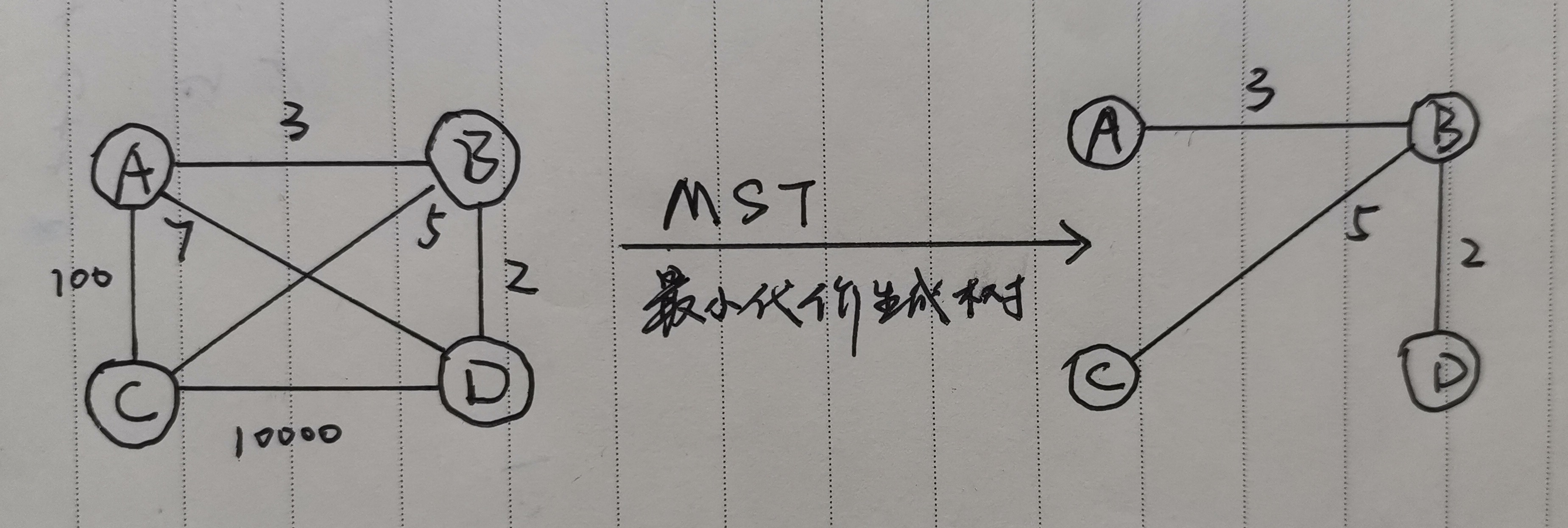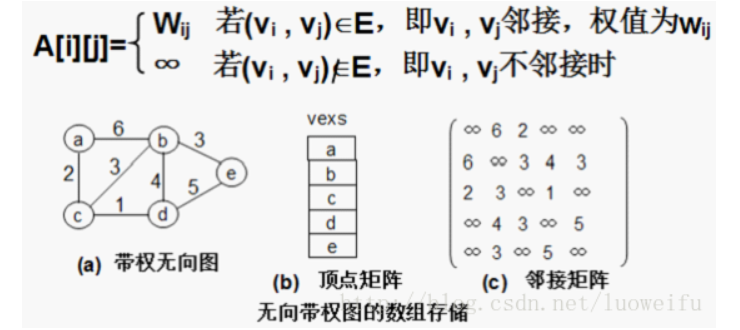图的存储方式
如何表达图?生成图?图又分为无向图,有向图,它们该怎么表示
对于图G = (V,{E}),其中V表示顶点集合,E则是边的集合
邻接表
邻接表有下列两个结构:
- 顶点表
- 边表
结构如下:

以无向图为例:


参考: 图的邻接表表示法(C语言)
邻接矩阵
以无向图为例:
第一种是无向无权图的建模,无向无权图G=(V,E)有n(n≧1)个顶点,其邻接矩阵是n阶对称方阵,两顶点联通则为1,否则为0,其元素的定义如下:
![Optional title 无向无权图]()
第二种是无向有权图,这时矩阵值就是权值了,如果两顶点不连通则为正∞,建模如下:
![Optional title 无向有权图]()
参考: 邻接矩阵表示法
统一图的表达
由于图的实现结构多种多样,对于每一种结构,都有一套不同的图运算api,因此要想掌握全部的图的表达方式非常困难,因此为了解题更加方便快速,我们应该选择自己喜欢和熟练的图的表达方式来实现所有的api,那么面对不同的结构,我们只需要将陌生的图结构转换成我们准备好的图结构就好了
我的图结构(邻接表)
- 图的总结构:即顶点集和边集
1
2
3
4
5
6
7
8
9
10
11
public class Graph{
//顶点集:key是顶点的编号,value是顶点的实际结构,如果顶点结构较为简单,可以将哈希表替换为数组,这样效率会更高
public HashMap<Integer, Node> nodes;
//边集,Edge是边的结构
public HashSet<Edge> edges;
public Graph(){
nodes = new HashMap<>();
edges = new HashSet<>();
}
}
- 顶点的实际结构
Node
1
2
3
4
5
6
7
8
9
10
11
12
13
14
15
16
17
18
public class Node{
//入度(无向图出度和入度相等)
public int in;
//出度
public int out;
//由当前顶点发散出去的边所连接的其他顶点(也被称为直接邻居)
public ArrayList<Node> nexts;
//当前顶点发散出去的边的集合
public ArrayList<Edge> edges;
public Node(int value){
this.value = value;
in = 0;
out = 0;
nexts = new ArrayList<>();
edges = new ArrayList<>();
}
}
- 边的实际结构
Edge
1
2
3
4
5
6
7
8
9
10
11
12
public class Edge{
//权值
public int weight;
public Node from;
public Node to;
public Edge(int weight, Node from, Node to){
this.weight = weight;
this.from = from;
this.to = to;
}
}
- 图的接口函数
1
2
3
4
5
6
7
8
9
10
11
12
13
14
15
16
17
18
19
20
21
22
23
24
25
26
27
28
29
30
31
32
33
34
35
36
public class GraphGenerator{
/**
* matrix是一个n*3的矩阵,其中n代表节点个数,这应该是个有向图
* 结构:【weight, from节点上的值,to节点上面的值】
*/
public static Graph createGraph(Integer[][] matrix){
Graph graph = new Graph();
for (int i = 0; i < matrix.length; i++) {
Integer weight = matrix[i][0];
Integer from = matrix[i][1];
Integer to = matrix[i][2];
//初始化图的顶点集,key为value,如果在图的顶点集中已经存在,就不需要存了
if (!graph.nodes.containsKey(from)) {
graph.nodes.put(from, new Node(from));
}
if(!graph.nodes.containsKey(to)){
graph.nodes.put(to, new Node(to));
}
//初始化起点,终点,和边的实际结构
Node fromNode = graph.nodes.get(from);
Node toNode = graph.nodes.get(to);
Edge newEdge = new Edge(weight, fromNode, toNode);
//给起点添加直接领居
fromNode.nexts.add(toNode);
//出度++
fromNode.out++;
//终点的入度++
toNode.in++;
//添加到起点的发散的边集中
fromNode.edges.add(newEdge);
//添加到图的边集中
graph.edges.add(newEdge);
}
}
}
图的宽度优先遍历
基本思路:
- 利用队列实现
- 从源节点开始依次按照宽度进队列,然后弹出
- 每弹出一个点,把该节点所有没有进过队列的邻接点放入队列
- 直到队列变空
code如下:
1
2
3
4
5
6
7
8
9
10
11
12
13
14
15
16
17
18
19
20
21
22
23
24
25
26
27
public class GraphGenerator{
//从图的某个顶点出发
public static void bfs(Node node){
if(node == null){
return;
}
Queue<Node> queue = new LinkedList<>();
//相比于二叉树,图是可能存在环的,而set的作用就是为了避免遍历因为环陷入死循环,
//我们将已经遍历的顶点记录在set中,这样就不会重复遍历了
HashSet<Node> set = new HashSet<>();
queue.add(Node);
set.add(node);
while(!queue.isEmpty()){
Node cur = queue.poll();
//如果是其他处理逻辑,就替换打印操作就行了
System.out.println(cur.value);
for (Node next : cur.nexts) {
//如果顶点已存在set中,那么不对它重复处理,也就是不加到队列
if(!set.contains(next)){
set.add(next);
queue.add(next);
}
}
}
}
}
图的广度优先遍历
基本思路:
- 利用栈实现
- 从源节点开始依次按照深度放入栈,然后弹出
- 每弹出一个点,把该节点下一个没有进过栈的邻接点放入栈
- 直到栈变空
code如下:
1
2
3
4
5
6
7
8
9
10
11
12
13
14
15
16
17
18
19
20
21
22
23
24
25
26
27
28
29
30
31
32
33
public class GraphGenerator{
//从图的某个顶点出发
public static void dfs(Node node){
if(node == null){
return;
}
Stack<Node> stack = new Stack<>();
//相比于二叉树,图是可能存在环的,而set的作用就是为了避免遍历因为环陷入死循环,
//我们将已经遍历的顶点记录在set中,这样就不会重复遍历了
HashSet<Node> set = new HashSet<>();
stack.add(Node);
set.add(node);
//如果是其他处理逻辑,就替换打印操作就行了
System.out.println(cur.value);
//最后栈的弹出顺序就是深搜路径
while(!stack.isEmpty()){
Node cur = stack.pop();
for (Node next : cur.nexts) {
//如果顶点已存在set中,说明已经在深搜路径当中了,我们应该找还没走过的路
if(!set.contains(next)){
//先逮住一个直接邻居,一路走到黑,同时会把当前节点重新压入栈中,因为该入口可以还有其他路需要探索
stack.push(cur);
stack.push(next);
set.add(next);
System.out.println(next.value);
//深搜路径继续延申,这是我们来到了新的路口,所以退出上一个路口的循环
break;
}
}
}
}
}
拓扑排序
- 适用范围:要求有向图,且有入度为0的节点,且没有环(没有循环依赖,假设存在循环依赖,那么可能压根就没有入度为0的节点,这样也就求不出拓扑排序)
- 适用场景:依赖的编译顺序,即依赖A需要先编译,因为编译依赖B的时候需要依赖A,这时的顺寻就是
A -> B
算法步骤:
- 找到入度为0的节点,放入队列
- 从队列中弹出节点,放到顺序数组中,将这个节点的直接邻居的入度-1,相当于把这个节点和它发散出去的边从图中消除
- 重复1,2操作,直到队列为空,返回顺序数组
code如下:
1
2
3
4
5
6
7
8
9
10
11
12
13
14
15
16
17
18
19
20
21
22
23
24
25
26
27
28
29
30
31
32
33
public class GraphGenerator{
public static List<Node> sortedTopology(Graph graph){
//hash表记录每个节点当前的入度,key为节点node,value为入度,value会随着入度为0的节点及其发散边的消除而变化
HashMap<Node, Integer> inMap = new HashMap<>();
//只有入度为0的时候才会放到这个队列
Queue<Node> zeroInQueue = new LinkedList<>();
//1.初始化inMap
//2.并且找到第一批的入度为0的节点(注意入度为0的节点可以一次性会有多个)
for (Node node : graph.nodes.values()) {
inMap.put(node, node.in);
if(node.in == 0){
zeroInQueue.add(node);
}
}
//顺序数组
List<Node> result = new ArrayList<>();
while(!zeroInQueue.isEmpty()){
Node cur = zeroInQueue.poll();
result.add(cur);
//将入度为0的节点的影响消除,并且找出下一批的入度为0的节点
for (Node node : cur.nexts) {
//将邻居节点的入度-1
inMap.put(next, inMap.get(next)-1);
if(inMap.get(next) == 0){
zeroInQueue.add(next);
}
}
}
return result;
}
}
最小生成树
请思考一个问题:假设要在n个城市之间建立通信联络网,则联通n个城市只需要n-1条线路,那么如何在最省经费的前提下建立这个通信网?因为n个城市之间,最多可能设置n(n-1)/2条线路,那么如何在这些可能的线路中选择n-1条,使得总的耗费最少呢? 
下面将介绍两种解决【构造连通网的最小代价生成树】问题的方法:
- Prim算法
- Kruskal算法
Kruskal
基本思路:首先假设对于非连通图T = (V, {}),此时只有顶点集,没有边,现在依次将代价最小的边加入,如果加入的边在在图中会形成环,那么这条边就不加了,遍历所有的边执行上述相同的操作,最后生成的图就是最小生成树
如果判断是否会形成环
首先假设对于非连通图T = (V, {}),每个顶点自成一个连通分量,若代价最小的边的依附的顶点分别在不同的连通分量中,就加入T中,否则不加入,加入之后,该连通分量就是这两个顶点的集合
总结步骤如下:
- 最初每个顶点自成一个连通分量(初始化工作)
- 准备一个依照边的权值从小到大的排序集合(例如小根堆,每次弹出的就是最小代价的边)
- 依次加入代价最小的边,如果边E依附的顶点A和B在不同的连通分量就加入到T中,并且将两个连通分量合并成一个,即将{A}与{B}合并成{A,B},那么原来的连通分量{A},{B}就不存在了(合并操作)
- 重复上诉操作,直到遍历了所有的边(循环遍历操作)
补充: 1.连通图:任意两个节点之间都有一条联通的路径,则是连通图,否则叫做非连通图
2.连通分量:即极大连通子图,如下图【连通分量】 
在该图片中,图G由三个部分组成,{0,1,2,3,4,5,6},{7,8},{9,10,11,12},而这三个部分就是图G的三个连通分量
code如下:
1
2
3
4
5
6
7
8
9
10
11
12
13
14
15
16
17
18
19
20
21
22
23
24
25
26
27
28
29
30
31
32
33
34
35
36
37
38
39
40
41
42
43
44
45
46
47
48
49
50
51
52
53
54
55
56
57
58
59
60
61
62
63
64
65
public class Kruskal{
//每个顶点对应的连通分量
private HashMap<Node, List<Node>> setMap;
private Kruskal(){
setMap = new HashMap<>()
}
/**
* 初始化连通分量,起初每个顶点自成一个连通分量
*/
public void makeSets(List<Node> nodes){
for (Node cur : nodes) {
List<Node> set = new ArrayList<Node>();
set.add(cur);
setMap.put(cur, set);
}
}
/**
* 判断边两个顶点是否在同一个连通分量中
*/
public boolean isSameSet(Node from, Node to){
List<Node> fromSet = setMap.get(from);
List<Node> toSet = setMap.get(to);
//两个集合不是同一个集合,即同一个连通分量
return fromSet == toSet;
}
/**
* 将边的两个顶点所属的不同的连通分量合并在一起
*/
public void union(Node from, Node to){
List<Node> fromSet = setMap.get(from);
List<Node> toSet = setMap.get(to);
//将其中一个连通分量的顶点合并到另一个连通分量中,并更新setMap
for (Node toNode : toSet) {
fromSet.add(toNode);
setMap.put(toNode, fromSet);
}
}
public static Set<Edge> kruskalMST(Graph graph){
Kruskal kruskal = new Kruskal();
//初始化连通分量
kruskal.makeSets(graph.nodes.values());
PriorityQueue<Edge> pq = new PriorityQueue<>(new Comparator<Edge>(){
public int compare(Edge o1, Edge o2) {
return o1.weight - o2.weight;
}
});
//准备好最小代价的边的排序集合
for (Edge edge : graph.edges) {
pq.add(edge);
}
Set<Edge> result = new HashSet<>();
while(!pq.isEmpty()){//遍历每条边
Edge edge = pq.poll();
if(!kruskal.isSameSet(edge.from, edge.to)){
result.add(edge);
kruskal.union(edge.from, edge.to);
}
}
return result;
}
}
Prim
基本思路:首先对于图N = (V, {E}),任意选择一个顶点作为起始连通分量U,我们从U = {u0}(u0 ε V),TE = {}开始,其中TE是最小生成树边的集合,重复进行下面的操作:在所有的u ε U,v ε V-U 的边(u, v) ε E中找到一条代价最小的边(u0,v0)添加到TE中,并将v0并入到连通分量U中,直到U = V为止,此时T = (U, {TE})就是MST。
Prim算法和Kruskal算法的关系
其实Prim的思路和kruskal的思路是一样的,都是在不同的连通分量通过最小代价的边进行融合,最后形成MST,在kruskal中是不同的连通分量随机融合,而Prim算法中,融合的连通分量一方是固定的,即U,另一方就是V-U,V-U是剩余顶点(也就是连通分量的集合)
Code如下:
1
2
3
4
5
6
7
8
9
10
11
12
13
14
15
16
17
18
19
20
21
22
23
24
25
26
27
28
29
30
31
32
33
public class Prim{
public static Set<Edge> primMST(Graph graph){
PriorityQueue<Edge> pq = new PriorityQueue<>(new Comparator<Edge>(){
public int compare(Edge o1, Edge o2) {
return o1.weight - o2.weight;
}
});
//初始连通分量
HashSet<Node> uSet = new HashSet<>();
//MST的边的集合
Set<Edge> teSet = new HashSet<>();
for (Node node : graph.nodes.values()) {//这个遍历保证V中的所有顶底最终都会合并到uSet中
if(!uSet.contains(node)){//第一个随机的初始点形成最初的连通分量
uSet.add(node);
for (Edge edge : node.edges) {//把所有的边存入pq,注意这里会有重复的边,也就是边的两个顶点都在uSet中的,但是不慌后面的if条件会筛掉
pq.add(edge);
}
while(!pq.isEmpty()){
Edge edge = pq.poll(); //弹出连通分量的所有顶点发散的边中的最小边
Node toNode = edge.to;
if(!uSet.contains(toNode)){//筛掉重复的边(边的两个顶点都在uSet中)
set.add(toNode); //合并V-U中的顶点
teSet.add(edges); //将最小代价边添加到MST的边集合中
for (Edge nextEdge : toNode.edges) {
pq.add(nextEdge);
}
}
}
}
}
}
}
从代码量来看Prim算法完胜,但相对kruskal要更加难理解写
总结
Kruskal和Prim算法针对的都是无向图的最小生成树(MST)算法
单源最短路径
这个算法就是求某个源点到其他各顶点的最小距离,因此这种算法必须决定一个源点,下面介绍解决该问题的算法:
- Dijkstra算法
Dijkstra
基本思路:
- 选一个源点A,初始化源点到其他顶点的距离(包括源点自己)序列,此时到其他源点的距离为正无穷,到源点自己的距离是0
- 从最短距离序列中,找出到源点距离最小的顶点B,用该顶点去更新其他顶点到源点的距离(包括他自己),即假设更新的顶点是C,原本
A -> C,距离是10,而A -> B距离是2,B -> C距离是5,所以A -> B -> C距离是7,比原本距离短,就更新,否则不更新。选到的点后面就不再选了,比如B这一轮更新完后,下一轮就不再选它 - 重复2的操作,直到所有顶点都被选过
注意:Dijkstra 没有负数的边,所以它是不支持负值的,并且不能存在环(从后面的代码中看:在计算最小距离的时候负值和环都是不允许存在的,否在会导致程序错误)
code如下:
1
2
3
4
5
6
7
8
9
10
11
12
13
14
15
16
17
18
19
20
21
22
23
24
25
26
27
28
29
30
31
32
33
34
35
36
37
38
39
40
41
42
43
44
45
46
47
48
49
public class Dijkstra{
/**
* head就是选择的源点
*/
public static HashMap<Node, Integer> dijkstra(Node head){
HashMap<Node, Integer> distanceMap = new HashMap<>(); //代表node到head的距离n,value就是n
//初始时,只有head到自己的距离,并且value=0,其他未添加的表示距离为正无穷
distanceMap.put(head, 0)
//存放已经选过的顶点
HashSet<Node> selectedNodes = new HashSet<>();
//获取距离到head最小的顶点,并用它更新其他顶点到head的距离
Node minNode = getMinDistanceAndUnselectedNode(distanceMap, selectedNodes);
//当所有顶点都被选过后,停止循环
while(minNode != null){
int distance = distanceMap.get(minNode);
for (Edge edge : minNode.edges) {
Node toNode = edge.to;
//如果顶点到head的初始距离为正无穷,则直接更新
if(!distanceMap.containsKey(toNode)){
distanceMap.put(toNode, distance + edge.weight);
}
//否则将原来的距离与更新后的距离比较,留下最小的
distanceMap.put(toNode, Math.min(distanceMap.get(toNode), distance + edge.weight));
}
//一轮更新完成,将minNode打入到selectedNodes
selectedNodes.add(minNode);
minNode = getMinDistanceAndUnselectedNode(distanceMap, selectedNodes);
}
return distanceMap;
}
public static Node getMinDistanceAndUnselectedNode(HashMap<Node, Integer> distanceMap, HashSet<Node> touchedNodes){
Node minNode = null;
int minDistance = Integer.MAX_VALUE;
//遍历所有顶点,找出没有选过并且距离最小的顶点
for (Entry<Node, Integer> entry : distanceMap.entrySet()) {
Node node = entry.getKey();
int distance = entry.getValue();
if(!touchedNodes.contains(node) && distance < minDistance){
minNode = node;
minDistance = distance;
}
}
return minNode;
}
}
Dijkstra的堆加速算法
思路:
未优化时从 distanceMap 中选取一个最小并且没有被用过的 Node 是采用 for 循环遍历的方式,而为了加速算法我们可以通过小根堆优化这个步骤:
- 起初将所有数据放入小根堆,每次弹出一个值,用于更新其他 Node 到 head 的距离
- 在堆中更新值,有需要保持小根堆的结构系统自带的实现是做不到的,因此我们需要手写堆,并对这种更新操作进行实现
code 如下:
1
2
3
4
5
6
7
8
9
10
11
12
13
14
15
16
17
18
19
20
21
22
23
24
25
26
27
28
29
30
31
32
33
34
35
36
37
38
39
40
41
42
43
44
45
46
47
48
49
50
51
52
53
54
55
56
57
58
59
60
61
62
63
64
65
66
67
68
69
70
71
72
73
74
75
76
77
78
79
80
81
82
83
84
85
86
87
88
89
90
91
92
93
94
95
96
97
98
99
100
101
102
103
104
105
106
107
108
109
110
111
112
113
114
115
116
public class Solution{
/**
* 从 head 出发,所有 head 能到达的节点,生成到达每个节点的最小路径记录并返回
* size:总共的节点数
* 返回值:每个 Node 到 head 的最短距离
*/
public static HashMap<Node, Integer> dijkstra2(Node head, int size){
NodeHeap nodeHeap = new NodeHeap(size);
/**
* addOrUpdateOrIgnore 方法
* add --> 每添加一条新的记录
* update --> 记录已存在,并且 Node 到 head 的距离更短,就更新
* ignore --> 记录已存在,但更新的距离要大,就忽略
*/
nodeHeap.addOrUpdateOrIgnore(head, 0);
HashMap<Node, Integer> result = new HashMap<>();
while(!nodeHeap.isEmpty()){
//每弹出一个 Node,更新它的直接节点
NodeRecord record = nodeHeap.pop();
Node cur = record.node;
int distance = record.distance;
for(Edge edge : cur.edges){
/**
* edge.to:直接节点
* edge.weight:到直接节点的距离
* distance:cur 到 head 的距离
*/
nodeHeap.addOrUpdateOrIgnore(edge.to, edge.weight + distance);
}
result.put(cur, distance);
}
return result;
}
public static class NodeRecord{
public Node node;
public int distance;
public NodeRecord(Node node, int distance){
this.node = node;
this.distance = distance;
}
}
public static class NodeHeap{
private Node[] nodes; //所有的节点放在 nodes 数组当中
private HashMap<Node, Integer> heapIndexMap; //堆中的 node 在数组中的 index,当 index == -1,表示 node 已经被选择过了
private HashMap<Node, Integer> distanceMap;
private int size;
public NodeHeap(int size){
nodes = new Node[size];
heapIndexMap = new HashMap<>();
distanceMap = new HashMap<>();
size = 0;
}
public boolean isEmpty(){
return size == 0;
}
public void addOrUpdateOrIgnore(Node node, int distance){
if(inHeap(node)){
distanceMap.put(node, Math.min(distanceMap.get(node), distance));
insertHeapify(node, heapIndexMap.get(node));
}
//从没进入过堆的,增加记录
if(!isEntered(node)){
nodes[size] = node;
heapIndexMap.put(node, size);
distanceMap.put(node, distance);
insertHeapify(node, size++);
}
}
public NodeRecord pop(){
NodeRecord nodeRecord = new NodeRecord(node[0], distanceMap.get(nodes[0]));
swap(0, size - 1);
heapIndexMap.put(nodes[size - 1], -1);
distanceMap.remove(nodes[size - 1]);
nodes[size - 1] = null;
heapify(0, --size);
return nodeRecord;
}
//有问题
private void insertHeapify(Node node, int index){
while(distanceMap.get(nodes[index]) < distanceMap.get(nodes[(index - 1) / 2])){
swap(index, (index - 1) / 2);
index = (index - 1) / 2;
}
}
//有问题
private void heapify(int index, int size){
int left = index * 2 + 1;
while(left < size){
int smallest = left + 1 < size && distanceMap.get(nodes[left + 1]) < distance ? left + 1 : left;
smallest = distanceMap.get(nodes[smallest]) < distanceMap.get(nodes[index]);
if(smallest == index){
break;
}
swap(smallest, index);
index = smallest;
left = index * 2 + 1;
}
}
private boolean isEntered(Node node){
return heapIndexMap.containsKey(node);
}
private boolean inHeap(Node node){
return isEntered(node) && heapIndexMap.get(node) != -1;
}
private void swap(int index1, int index2){
heapIndexMap.put(nodes[index1], index2);
heapIndexMap.put(nodes[index2], index1);
Node tmp = nodes[index1];
nodes[index1] = nodes[index2];
nodes[index2] = tmp;
}
}
}


